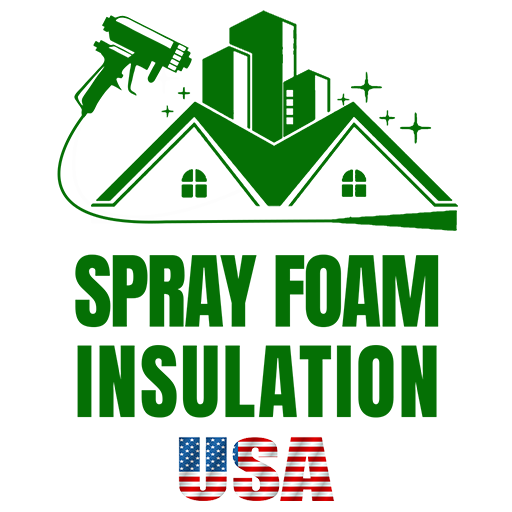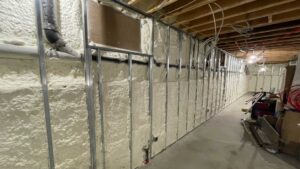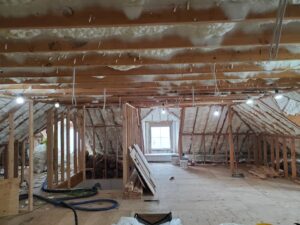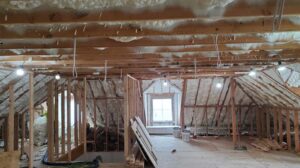Introduction
When considering how to boost your home’s energy efficiency and comfort, attic insulation types stand out as a crucial factor. A well-insulated attic keeps your home warmer in the winter and cooler in the summer, ultimately reducing your energy bills and enhancing indoor comfort. Here’s a quick rundown of insulation options:
- Fiberglass Insulation: Affordable and DIY-friendly, available in batts and rolls.
- Cellulose Insulation: Made from recycled paper; excellent for blocking air leaks.
- Mineral Wool Insulation: Provides great fire resistance and soundproofing.
- Spray Foam Insulation: Offers high R-value and creates an airtight seal.
- Rigid Foam Board Insulation: Excellent for moisture resistance and high R-values.
In a nutshell, choosing the right type of attic insulation can significantly impact your energy costs and overall home comfort. Whether you live in the bustling streets of New York or the breezy landscapes of New Jersey, upgrading your attic insulation is a smart move towards a more energy-efficient, comfortable home.
Understanding Attic Insulation Types
When upgrading your attic insulation, it’s crucial to understand the different materials available. Each type has unique properties that can affect your home’s energy efficiency and comfort. Let’s dive into the main types: Fiberglass, Cellulose, Mineral wool, Spray foam, and Rigid foam board.
Fiberglass Insulation
Fiberglass is one of the most common attic insulation types due to its affordability and ease of installation. It comes in batts and rolls that fit between studs and joists:
- Pros: Cost-effective, DIY-friendly, widely available.
- Cons: Lower R-value per inch, can irritate skin and lungs during installation.
Cellulose Insulation
Made from recycled paper treated with fire retardants, cellulose is an eco-friendly option. It’s typically blown into attics, filling nooks and crannies for better coverage.
- Pros: Higher R-value per inch, excellent for irregular spaces.
- Cons: Can settle over time, potentially reducing effectiveness.
Mineral Wool Insulation
Also known as rock wool, this insulation is derived from natural rocks or industrial waste. It offers superior fire resistance and soundproofing.
- Pros: Fire-resistant, moisture-resistant, good thermal and acoustic insulation.
- Cons: Higher cost, denser and heavier than other types.
Spray Foam Insulation
Spray foam provides the highest R-value per inch and creates an excellent air and moisture barrier when applied. This type is ideal for sealing gaps and leaks in the attic.
- Pros: Superior air sealing, high R-value, moisture barrier.
- Cons: Higher cost, requires professional installation.
Rigid Foam Board Insulation
Rigid foam boards are excellent for adding insulation over large areas. They can be used on attic floors or walls and are particularly effective against thermal bridging.
- Pros: High insulating value, moisture resistance.
- Cons: More difficult to install, can be more expensive than other options.
Each type of insulation offers unique benefits and challenges. Your choice will depend on factors like your climate, budget, and specific needs for moisture resistance, fire safety, and ease of installation. For instance, if moisture is a concern in your area, rigid foam board might be the best option. On the other hand, if you’re looking for an all-around performer with excellent air sealing properties, spray foam could be the ideal solution.
In the next section, we’ll explore how to choose the right R-value for your attic to maximize energy savings and enhance comfort.
Choosing the Right R-Value for Your Attic
Choosing the correct R-value for your attic insulation is crucial for maximizing energy efficiency and maintaining comfort in your home. Here’s how to make the best choice based on climate considerations, insulation depth, and potential energy savings.
Climate Considerations
The R-value needed for your attic largely depends on the climate you live in:
- Cold Climates: In areas with harsh winters, a higher R-value is necessary to keep the warmth in. Typically, an R-value of R-49 is recommended.
- Warm Climates: In hotter regions, while a high R-value is still beneficial for keeping your home cool, the focus might also be on installing a radiant barrier to reflect heat.
- Mixed Climates: If you experience a mix of hot summers and cold winters, aim for a high R-value and consider the addition of a radiant barrier if your attic receives significant sun exposure.
Insulation Depth
The depth of your insulation also plays a role in its effectiveness. The recommended depths for different R-values are:
- R-38 is usually around 12 to 14 inches of insulation.
- R-49 can go up to 16 to 18 inches.
Ensuring that your insulation is deep enough to meet these standards is key to achieving the desired R-value and ensuring effective thermal resistance.
Energy Savings
Properly insulating your attic can lead to significant energy savings. By choosing the right R-value for your climate and ensuring adequate insulation depth, you can reduce your heating and cooling costs by up to 15%. This not only makes your home more energy-efficient but also contributes to a more consistent indoor temperature, enhancing overall comfort.
The investment in higher R-value insulation often pays off in the long term through reduced energy bills. Each step up in R-value means greater resistance to heat flow, which translates to better energy conservation inside your home.
In summary, selecting the right R-value for your attic based on your local climate, ensuring adequate insulation depth, and understanding the potential for energy savings are crucial steps in optimizing your home’s thermal efficiency. Next, we will look at the pros and cons of popular attic insulation types to help you decide which material is best suited for your needs.
Pros and Cons of Popular Attic Insulation Types
When it comes to choosing the right attic insulation, understanding the strengths and weaknesses of each type can guide you to make the best decision for your home. Here’s a breakdown of the most common attic insulation types and their pros and cons:
Fiberglass Insulation
Pros:
– DIY-friendly: Easy to install for those who prefer to do it themselves.
– Affordability: One of the most cost-effective options available.
– Availability: Widely available in various sizes and thicknesses.
Cons:
– Lower R-value: Less effective per inch at preventing heat flow compared to other materials.
– Irritation: Can irritate the skin and lungs, so protective gear is necessary during installation.
Cellulose Insulation
Pros:
– Eco-friendliness: Made from recycled paper, making it a greener choice.
– Higher R-value: Provides better insulation per inch than many fiberglass products.
– Dense material: Good at blocking air flow, which can help prevent energy loss.
Cons:
– Moisture concerns: Can absorb moisture, which might lead to mold issues if not properly managed.
– Settling: May settle over time, which can decrease its effectiveness unless properly maintained.
Mineral Wool Insulation
Pros:
– Fire resistance: Highly resistant to fire, providing an added safety benefit.
– Moisture resistance: Does not absorb water, which helps prevent mold and mildew.
– Soundproofing: Excellent acoustic properties to reduce noise.
Cons:
– Cost: Generally more expensive than fiberglass.
– Irritation: Like fiberglass, it can be irritating to the skin and lungs during installation.
Spray Foam Insulation
Pros:
– High R-value: Offers a superior R-value, enhancing energy efficiency.
– Air sealing: Expands to fill gaps, providing exceptional air sealing capabilities.
– Longevity: Durable and maintains performance over time.
Cons:
– Professional installation required: Must be installed by professionals, adding to the cost.
– Expense: More costly than most other types of insulation.
– Chemical sensitivity: The chemicals involved can be harmful before they cure, requiring careful handling.
Rigid Foam Board Insulation
Pros:
– High R-value per inch: Excellent thermal resistance, making it ideal for limited spaces.
– Moisture resistance: Resists water absorption, protecting against moisture problems.
– Versatility: Can be used in various parts of the home, including below grade.
Cons:
– Installation complexity: Requires precise cutting and fitting, which might be challenging for DIY.
– Cost: More expensive upfront than some other options like fiberglass.
– Sealing required: Gaps must be sealed properly to prevent air leaks.
Each type of insulation has its unique set of characteristics that may make it the perfect choice for one home but less ideal for another. Consider your specific needs, such as budget, climate, and whether you’re looking for a DIY project or a professional installation. By weighing these pros and cons, you can select the insulation that best fits your requirements and enhances your home’s energy efficiency and comfort.
Installation Tips for Maximum Efficiency
Properly installing attic insulation is crucial for maximizing energy efficiency and comfort in your home. Here are some essential tips on air sealing, ensuring proper ventilation, and avoiding common installation mistakes.
Air Sealing
Before adding new insulation, air sealing is a critical first step. This process involves identifying and sealing air leaks to prevent conditioned air from escaping your attic. Common leak sources include:
- Around light fixtures
- Electrical boxes
- Ductwork
- Plumbing vents
Use caulk or spray foam to seal these leaks. This simple action can significantly enhance the overall effectiveness of your insulation by keeping the warm or cool air where it belongs—inside your home.
Proper Ventilation
While sealing your attic is important, maintaining proper ventilation is equally crucial. Good ventilation helps to:
- Prevent moisture accumulation
- Reduce the risk of mold and mildew
- Extend the life of roofing materials
Ensure that soffit vents are unblocked and that there is adequate air flow from the soffits to the ridge vent. This helps to keep the attic space dry and prevents the degradation of insulation materials over time.
Avoiding Common Mistakes
Several common pitfalls can undermine the effectiveness of attic insulation. Here’s how to avoid them:
1. Do Not Compress Insulation:
Compressing insulation reduces its R-value, diminishing its insulating properties. Always lay insulation materials flat and avoid placing heavy objects on top.
2. Keep Insulation Away from Light Fixtures:
Unless they are rated for insulation contact (IC-rated), keep insulation away from light fixtures to prevent fire hazards.
3. Do Not Block Vents:
While insulating, make sure not to cover soffit vents, ridge vents, or other ventilation systems. Blocked vents can lead to moisture problems and reduced air quality.
By following these installation tips, you can ensure that your attic insulation is as effective as possible, helping to reduce energy costs and improve the comfort of your home. The key to effective attic insulation is not just in choosing the right materials but also in how well they are installed.
Frequently Asked Questions about Attic Insulation
What is the best type of insulation for attics?
Choosing the best type of insulation for your attic depends on several factors including your climate, budget, and specific home needs. Here are some common attic insulation types:
- Fiberglass: Widely used due to its affordability and ease of installation. It’s suitable for DIY projects but has a lower R-value per inch compared to other materials.
- Cellulose: Made from recycled paper, cellulose is eco-friendly and has a higher R-value than fiberglass. It’s effective for blocking air leaks but can absorb moisture.
- Mineral Wool: Offers excellent fire resistance and doesn’t absorb moisture like fiberglass or cellulose. However, it’s generally more expensive.
- Spray Foam: Provides high R-value and exceptional air sealing properties. It requires professional installation but is highly effective in preventing heat transfer.
- Rigid Foam Board: Great for areas needing high moisture resistance. It has a high R-value but can be more challenging to install.
How do I know if my attic is properly insulated?
To determine if your attic is properly insulated, check for visible floor joists. If the insulation is level with or below the joists, you likely need to add more. Also, consider the uniformity of the insulation; it should cover the attic floor evenly without gaps. A well-insulated attic will help maintain stable temperatures throughout your home and reduce energy bills.
Can I mix different types of insulation?
Yes, different types of insulation can be mixed, but it must be done correctly to ensure effectiveness. For example, you can add loose-fill cellulose over existing fiberglass batts to increase the overall R-value. However, always ensure that materials like spray foam, which act as a vapor barrier, are not placed over other forms that need to breathe, such as fiberglass or cellulose without proper ventilation strategies in place.
By understanding these key points and choosing the right insulation for your specific needs, you can maximize the comfort and energy efficiency of your home. The effectiveness of attic insulation is not only about the type of material but also how well it is installed and maintained.
Conclusion
When it comes to enhancing your home’s energy efficiency and comfort, selecting the right attic insulation types is crucial. Throughout this guide, we’ve explored various options, each with its unique benefits and considerations. Now, let’s wrap up with some key insights on how the right attic insulation can lead to significant energy savings and a more comfortable living environment.
Energy Savings: One of the most compelling benefits of proper attic insulation is the potential for substantial energy savings. By creating a barrier that limits heat flow between your home and the outside environment, well-installed insulation helps maintain a consistent indoor temperature. This reduction in energy required for heating and cooling can lead to lower utility bills and a smaller carbon footprint. For instance, using high R-value materials like spray foam can optimize your energy efficiency, ensuring that your heating and cooling systems work less to achieve the same level of comfort.
Home Comfort: Beyond the savings, the comfort of your home environment sees remarkable improvement with proper attic insulation. Materials such as spray foam create an airtight seal that eliminates drafts and cold spots. This means during the winter months, your home stays warm and cozy, and in the summer, it remains cool and pleasant. The consistency in indoor temperature adds to the overall comfort and livability of your space, making it a joy to live in regardless of the season.
Choosing Spray Foam Insulation USA: At Spray Foam Insulation USA, we specialize in providing top-tier attic insulation solutions that cater to these very needs. Our expertise in spray foam insulation, in particular, positions us as a leading choice for homeowners aiming to boost their home’s energy efficiency and comfort. We offer customized insulation strategies designed to suit the specific requirements of your home, ensuring optimal installation and performance.
By partnering with us, you not only invest in quality materials but also in professional service that guarantees a successful insulation project. Our commitment to excellence and customer satisfaction means that you can trust us to enhance your home’s efficiency and comfort, making it a better place to live.
In conclusion, whether you’re looking to save on energy costs, improve your home’s comfort, or both, attic insulation is a smart and effective solution. With the right approach and expertise provided by Spray Foam Insulation USA, you can enjoy a more energy-efficient and comfortable home for years to come. Ready to take the next step? Contact us today for a comprehensive consultation and see how we can transform your attic into a space of comfort and efficiency.





